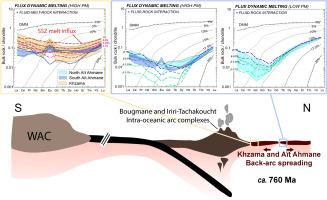当前位置:
X-MOL 学术
›
Gondwana Res.
›
论文详情
Our official English website, www.x-mol.net, welcomes your
feedback! (Note: you will need to create a separate account there.)
The Moroccan Anti-Atlas ophiolites: Timing and melting processes in an intra-oceanic arc-back-arc environment
Gondwana Research ( IF 7.2 ) Pub Date : 2020-10-01 , DOI: 10.1016/j.gr.2020.05.014 F. Hodel , A. Triantafyllou , J. Berger , M. Macouin , J.-M. Baele , N. Mattielli , C. Monnier , R.I.F. Trindade , M.N. Ducea , A. Chatir , N. Ennih , J. Langlade , M. Poujol
Gondwana Research ( IF 7.2 ) Pub Date : 2020-10-01 , DOI: 10.1016/j.gr.2020.05.014 F. Hodel , A. Triantafyllou , J. Berger , M. Macouin , J.-M. Baele , N. Mattielli , C. Monnier , R.I.F. Trindade , M.N. Ducea , A. Chatir , N. Ennih , J. Langlade , M. Poujol

|
Abstract The Moroccan Anti-Atlas orogenic belt encloses several Precambrian inliers comprising two major Neoproterozoic ophiolitic complexes: the Sirwa and Bou Azzer ophiolites. These ophiolites expose crustal and mantle units, thrusting over fragments of a long-lived intra-oceanic arc system. We present a detailed geochronological and petro-geochemical study of three mafic/ultramafic units of these two ophiolites: the Khzama sequence (Sirwa ophiolite) and the Northern and Southern Ait Ahmane sequences (Bou Azzer ophiolite). The crystallization of layered metagabbros from the Bou Azzer ophiolite (North Ait Ahmane sequence) has been dated here at 759 ± 2 Ma (U-Pb on zircons). This new age for the Bou Azzer ophiolite is similar to the formation of the Sirwa ophiolite (762 Ma) and suggests that both units formed during the same spreading event. Metabasalts of the three units show tholeiitic signature but with variable subduction-related imprints marked by LILE enrichments, HFSE depletions and variable Ti contents, similar to modern back-arc basin basalts (BABB). Their back-arc origin is also supported by the geochemical signature of ultramafic units showing very low contents in major and trace incompatible elements (Al2O3: 0.12–1.53 wt%, Ti: 3.5–64.2 ppm and Nb: 0.004–0.10 ppm), attesting of a highly refractory protolith. This is in agreement with the high Cr# (0.44–0.81) and low to intermediate Mg# (0.25–0.73) of their constitutive Cr-spinels. Dynamic melting models suggest that these serpentinites experienced intense and polyphased hydrous melting events, strongly influenced by supra-subduction zone SSZ-fluid influx and subduction-related melt percolation. Being particularly affected by these SSZ-melt/rock interactions and closer to arc units to the south, the Sirwa ophiolite and the South Ait Ahmane unit of the Bou Azzer ophiolite likely represent an early stage of the arc-back-arc system, which has been more influenced by the magmatic products of the arc activity compared to the North Ait Ahmane unit of the Bou Azzer ophiolite.
中文翻译:

摩洛哥反阿特拉斯蛇绿岩:大洋内弧后弧环境中的时间和熔化过程
摘要 摩洛哥反阿特拉斯造山带包含几个前寒武纪内层,包括两个主要的新元古代蛇绿岩复合体:Sirwa 和 Bou Azzer 蛇绿岩。这些蛇绿岩暴露地壳和地幔单元,冲过一个长期存在的洋内弧系统的碎片。我们对这两种蛇绿岩的三个镁铁质/超镁铁质单元进行了详细的地质年代学和石油地球化学研究:Khzama 层序(Sirwa 蛇绿岩)以及北部和南部 Ait Ahmane 层序(Bou Azzer 蛇绿岩)。来自 Bou Azzer 蛇绿岩(North Ait Ahmane 层序)的层状变辉长岩的结晶已在 759 ± 2 Ma(锆石上的 U-Pb)确定。Bou Azzer蛇绿岩的这个新时代与Sirwa蛇绿岩(762 Ma)的形成相似,表明这两个单元是在同一扩张事件中形成的。三个单元的变玄武岩显示拉斑岩特征,但具有可变的俯冲相关印记,以 LILE 富集、HFSE 耗竭和可变 Ti 含量为标志,类似于现代弧后盆地玄武岩 (BABB)。它们的弧后起源也得到了超镁铁质单元的地球化学特征的支持,显示出主要和痕量不相容元素的含量非常低(Al2O3:0.12-1.53 wt%,Ti:3.5-64.2 ppm 和 Nb:0.004-0.10 ppm),证明一种高难熔的原岩。这与它们的组成型 Cr 尖晶石的高 Cr# (0.44–0.81) 和低至中等 Mg# (0.25–0.73) 一致。动态熔融模型表明,这些蛇纹岩经历了强烈的多相含水熔融事件,受到超俯冲带 SSZ 流体流入和俯冲相关熔体渗透的强烈影响。
更新日期:2020-10-01
中文翻译:

摩洛哥反阿特拉斯蛇绿岩:大洋内弧后弧环境中的时间和熔化过程
摘要 摩洛哥反阿特拉斯造山带包含几个前寒武纪内层,包括两个主要的新元古代蛇绿岩复合体:Sirwa 和 Bou Azzer 蛇绿岩。这些蛇绿岩暴露地壳和地幔单元,冲过一个长期存在的洋内弧系统的碎片。我们对这两种蛇绿岩的三个镁铁质/超镁铁质单元进行了详细的地质年代学和石油地球化学研究:Khzama 层序(Sirwa 蛇绿岩)以及北部和南部 Ait Ahmane 层序(Bou Azzer 蛇绿岩)。来自 Bou Azzer 蛇绿岩(North Ait Ahmane 层序)的层状变辉长岩的结晶已在 759 ± 2 Ma(锆石上的 U-Pb)确定。Bou Azzer蛇绿岩的这个新时代与Sirwa蛇绿岩(762 Ma)的形成相似,表明这两个单元是在同一扩张事件中形成的。三个单元的变玄武岩显示拉斑岩特征,但具有可变的俯冲相关印记,以 LILE 富集、HFSE 耗竭和可变 Ti 含量为标志,类似于现代弧后盆地玄武岩 (BABB)。它们的弧后起源也得到了超镁铁质单元的地球化学特征的支持,显示出主要和痕量不相容元素的含量非常低(Al2O3:0.12-1.53 wt%,Ti:3.5-64.2 ppm 和 Nb:0.004-0.10 ppm),证明一种高难熔的原岩。这与它们的组成型 Cr 尖晶石的高 Cr# (0.44–0.81) 和低至中等 Mg# (0.25–0.73) 一致。动态熔融模型表明,这些蛇纹岩经历了强烈的多相含水熔融事件,受到超俯冲带 SSZ 流体流入和俯冲相关熔体渗透的强烈影响。









































 京公网安备 11010802027423号
京公网安备 11010802027423号